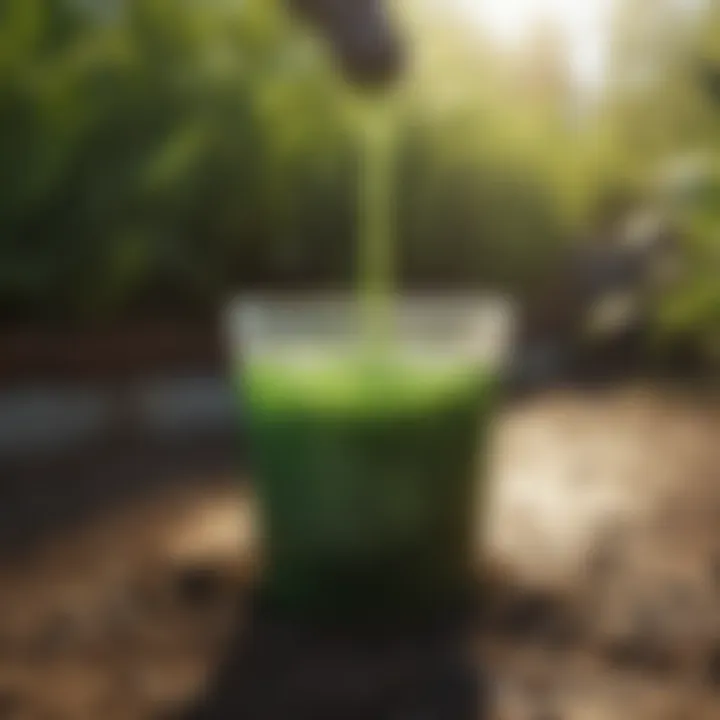Understanding Liquid Fertilizer Application Rates Effectively


Intro
Liquid fertilizers play a significant role in modern agriculture. Their application rates are critical to achieving optimal plant growth and productivity. Understanding how to effectively utilize these fertilizers can lead to higher crop yields, improved soil health, and better resource management.
Farmers and agronomists must adapt application rates to suit specific crops and environmental conditions. This article provides insights into the practices and methodologies surrounding liquid fertilizer application.
Topic Overview
Definition and Importance
Liquid fertilizers are soluble nutrient solutions applied to crops to enhance growth. Unlike granular fertilizers, they provide quick absorption and response from plants. This immediacy makes them appealing for both large-scale farming and small-scale gardening.
The importance of applying the correct rates cannot be overstated. Over-application can lead to nutrient runoff, harming water sources and ecosystems. Conversely, under-application may hinder plant growth, reducing yields.
Brief History and Evolution
The use of fertilizers dates back thousands of years, but liquid fertilizers surged in popularity in the 20th century. Early formulations were simple, but advancements have led to the development of complex solutions tailored for different plants and soils.
Today, liquid fertilizers include a variety of micronutrients that support healthy crop growth. Innovations in chemistry and agronomy have shaped liquid fertilizer offerings, making them often more efficient than traditional methods.
Key Techniques and Innovations
Sustainable Farming Practices
Sustainability is increasingly vital in agriculture. Implementing liquid fertilizers responsibly aids in minimizing environmental impact. Techniques such as precision application help in accurately targeting the nutrient needs of specific plants while reducing wastage.
Crop rotation and integrated pest management are other sustainable practices that work well with liquid fertilizer applications. They help maintain soil health and reduce dependence on chemical inputs.
Advanced Agronomic Technologies
Technological advances have significantly transformed liquid fertilizer application. Variable rate technology allows farmers to apply different amounts of fertilizers to varying areas within a field. This precision can maximize yields while conserving resources.
Data analytics tools are also emerging, providing insights about soil health and nutrient needs. Apps and software help farmers make informed decisions about when and how much to apply.
Practical Applications
Step-by-Step Guides
- Soil Testing: Start by conducting soil tests to determine nutrient levels. This information informs the type and amount of liquid fertilizer needed.
- Selection: Choose the appropriate fertilizer based on crop type and growth stage. For instance, nitrogen-based solutions may be suitable during the leafy growth phase.
- Application Timing: Apply fertilizers during periods of active plant growth to enhance nutrient uptake.
- Monitoring: Regularly monitor crop health and adjust application rates as needed. This ensures that nutrition levels remain optimal.
Case Studies or Real-World Examples
Many successful farms have adopted liquid fertilizer application technologies. For example, a mid-sized corn farm in Illinois increased yields by 20% after implementing precision application techniques. The use of soil maps allowed the farmer to identify specific regions in need of more nutrients.
Moreover, a vineyard in California noted a significant improvement in grape quality and fruit set after switching from granular fertilizers to liquid products. By applying smaller, more frequent doses, the vineyard optimized nutrient use and achieved superior results.
"Sustainable practices in using liquid fertilizers not only boost crop yields but also protect our environment."
Preface to Liquid Fertilizers
Liquid fertilizers are an essential component of modern agriculture. They provide a convenient method for delivering nutrients directly to crops. Understanding the various aspects of liquid fertilizers can enhance farming efficiency and crop yield.
The significance of liquid fertilizers lies in their ability to offer quick nutrient availability. When applied correctly, they can improve soil health and enhance plant growth. However, the complexity of choosing the right type and application rate makes it crucial for farmers to educate themselves about this matter.
Definition and Composition
Liquid fertilizers can be defined as nutrient solutions designed for application to soil and plants. These solutions may contain a variety of essential elements, including nitrogen, phosphorus, and potassium, as well as micronutrients like zinc and iron. The composition can vary widely between different products, affecting their suitability for particular crops or soil types.
Common compositions include:
- Synthetic solutions that are chemically formulated to provide balanced nutrient ratios.
- Organic liquid fertilizers derived from natural sources, such as seaweed or manure, which improve soil microbial activity.
Each type has its advantages and disadvantages, influencing not only plant growth but also environmental health.
Types of Liquid Fertilizers
There are several types of liquid fertilizers, each designed to meet specific farming needs. Understanding the differences can help farmers select the most appropriate product for their crops and soil conditions.
- Urea Ammonium Nitrate: This is a popular type of nitrogen fertilizer. It offers high nitrogen content and is commonly used during the growing season.
- Fish Emulsion: An organic option that provides a range of nutrients. It’s beneficial for soil health and can enhance overall fertility.
- Foliar Fertilizers: These are applied directly to the leaves, allowing plants to absorb nutrients quickly through their foliage.
- Phosphoric Acid: Used mostly in phosphate fertilizers, it aids in root development and early growth in plants.
Choosing the right type depends on various factors, including soil conditions, crop types, and specific nutrient needs. Each option has its pros and cons in terms of effectiveness and environmental impact. Understanding these differences is key for achieving optimal results in the field.
Importance of Application Rates
Liquid fertilizer application rates are a fundamental aspect of agricultural practices. Understanding the right application rate is essential for both crop performance and environmental sustainability. The relationship between the amount of fertilizer used and crop yield can be profound. Misjudging these rates can lead to significant implications for productivity and ecological health.


Optimizing Crop Growth
The primary purpose of liquid fertilizers is to provide crops with the necessary nutrients for optimal growth. When application rates are tailored to the crop's specific needs, growth is stimulated effectively. With adequate nutrients, plants can resist diseases better, yield higher, and ultimately contribute to more successful harvests.
For instance, corn and soybeans require different nutrient profiles at various growth stages. Therefore, knowing the right amounts of nitrogen, phosphorus, and potassium is crucial. Application of fertilizers in the right proportions avoids competition for resources among plants, enhancing growth.
It is important to conduct regular soil tests to ascertain soil nutrient levels. This allows farmers to adjust application rates accordingly. Regular monitoring means that any deficiencies can be addressed early, promoting optimal crop development and yield. Using tools like yield maps can also guide farmers in making informed decisions about areas that require more precise applications of fertilizers.
Minimizing Environmental Impact
Another critical consideration regarding application rates is their environmental impact. Over-application of liquid fertilizers can lead to runoff, which contaminates waterways. This is problematic as it stimulates algal blooms, leading to dead zones in aquatic environments where oxygen levels drop.
Conversely, under-application can lead to nutrient deficiencies in crops, forcing farmers to compensate with potentially harmful chemical inputs later on. Therefore, it's essential to balance the application rates to achieve sustainability while still meeting crop needs.
Farmers can adopt several strategies to minimize environmental risks:
- Precision agriculture: Tailoring applications to specific sections of a field based on real-time data.
- Buffer zones: Leaving areas near water bodies untreated can help filter excess nutrients.
- Effective timing: Applying fertilizers before rainfall events can help reduce runoff.
"Understanding and adjusting liquid fertilizer application rates is paramount for both crop success and environmental stewardship."
Factors Affecting Application Rates
Understanding the factors that affect liquid fertilizer application rates is vital for optimizing agricultural practices. These factors outline the precise framework within which farmers must operate to achieve their goals. Different elements influence how effectively fertilizers can be applied, impacting not only crop yield but also soil health and environmental integrity. Recognizing these influences enables farmers to make informed decisions while applying liquid fertilizers.
Soil Type and Condition
Soil type and its condition are among the most critical parameters that determine application rates for liquid fertilizers. Each soil type—be it sandy, loamy, or clay—has unique characteristics that affect nutrient retention and availability.
- Sandy Soils: These typically have larger particles and can drain water quickly. Hence, liquid fertilizers may leach away quickly, necessitating higher application rates.
- Clay Soils: On the other hand, clay soils retain moisture well, making them more capable of holding nutrients. Here, lower application rates might be sufficient as the nutrients can stay longer in the soil.
Soil condition plays an essential role too. For instance, compacted or poorly aerated soils may hinder nutrient absorption, requiring adjustments in rates. Additionally, soil organic matter can influence how well fertilizers perform. High organic matter content can improve nutrient availability, while low content may require more careful nutrient management.
Crop Type and Growth Stage
Different crops have varying nutrient demands, affecting how much liquid fertilizer should be used. Each plant species has unique physiological characteristics that dictate its nutrient uptake.
For example, corn typically needs more nitrogen during its growth than beans, which may require less overall nitrogen but a balanced supply of other nutrients.
Moreover, the growth stage of the crop significantly influences nutrient requirements:
- Seedling Stage: At this point, less fertilizer is often needed as plants are establishing roots.
- Vegetative Stage: The demand for nutrients increases as plants grow larger and develop more leaves.
- Reproductive Stage: Here, nutrient requirements peak as plants prepare for flowering and fruiting.
Understanding these nuances helps in determining the optimal application rates based on crop requirements at each stage of development.
Weather Conditions
Weather conditions are unpredictable and can significantly affect the effectiveness of liquid fertilizer application. Rainfall, temperature, and wind can impact both the application rates and the retention of the fertilizers in the soil.
- Rainfall: Heavy rain shortly after application can lead to runoff, which may wash away fertilizers before they can be absorbed. In such cases, the application rates may need to be adjusted downward, or applications may need to be timed with dry conditions.
- Temperature: Higher temperatures can increase evaporation, influencing how much liquid fertilizer remains available to crops. Farmers are encouraged to apply fertilizers during cooler parts of the day to mitigate this effect.
- Wind: Wind can disperse fine mists of liquid fertilizers, leading to uneven application. In windy conditions, lower application rates or different application techniques might be necessary.
Nutrient Requirements
Each crop has specific nutrient requirements that vary throughout its life cycle. Liquid fertilizers must be tailored to meet these varying needs, ensuring that plants receive the right nutrients in the right amounts.
- Macronutrients: These include nitrogen, phosphorus, and potassium, which are essential for overall growth. Knowing the specific needs for these nutrients will guide farmers in determining application rates.
- Micronutrients: Trace elements like iron, zinc, and manganese may also be necessary but in smaller amounts. These often influence overall crop vigor.
Accurate nutrient management is pivotal in maintaining soil health and ensuring sustainable agricultural practices.
Farmers should regularly assess their soil and crop conditions to determine current nutrient needs, allowing for precise adjustments in liquid fertilizer application rates.
Methods of Determining Application Rates
Understanding how to accurately determine application rates for liquid fertilizers is crucial for agricultural success. This section explores three effective methods: soil testing, tissue testing, and nutrient management planning. Each method provides a pathway to optimize fertilizer application, ensuring both crop health and environmental sustainability.
Soil Testing
Soil testing is a fundamental practice in agriculture. It provides insights into the existing nutrient levels in the soil. By analyzing soil samples, farmers can gain a precise understanding of nutrient needs. This helps in making informed decisions about the amount and type of liquid fertilizer to apply.
Key considerations in soil testing include the following:
- Type of nutrients present: A complete analysis will indicate which nutrients are lacking.
- pH levels: This affects nutrient availability and can inform what amendments are necessary.
- Soil texture: Different soils retain nutrients differently, impacting how and when liquid fertilizers should be applied.
Ultimately, soil testing provides a scientific basis for fertilizer application, reducing the risk of under or over-application.
Tissue Testing
Tissue testing complements soil testing by analyzing the nutritional status of crops directly. Collecting and analyzing plant tissues gives farmers real-time data about nutrient uptake.


This method is beneficial because it provides:
- Current nutrient levels: It offers insights into what macro and micronutrients are present in the plant at the time of testing.
- Growth stage relevance: Nutritional needs vary with crop development stages. Tissue testing can indicate if a plant is receiving sufficient nutrients as it matures.
So, tissue testing allows farmers to adjust liquid fertilizer application rates mid-season, enhancing crop performance and preventing nutrient deficits.
Nutrient Management Planning
Nutrient management planning combines the results from both soil and tissue tests with broader agricultural practices. It involves creating a strategic plan that outlines how and when fertilizers should be applied, based on crop needs and soil health.
Effective nutrient management planning includes:
- Integrated approach: Incorporating other factors like crop rotation and organic amendments can improve soil fertility.
- Timely applications: Planning ensures fertilizers are applied at optimal times, reducing nutrient loss to runoff.
- Record-keeping: Documenting previous applications helps refine future strategies and assess effectiveness over time.
Application Techniques
Application techniques for liquid fertilizers play a critical role in ensuring effective nutrient delivery to crops. The choice of application method affects not only the efficiency of nutrient uptake but also the overall health of the soil and environment. Various techniques have emerged, each with unique advantages and scenarios for use. Understanding these methods allows farmers to optimize their fertilizer use, enhance crop yields, and mitigate ecological impact.
Foliar Application
Foliar application involves spraying fertilizers directly onto the leaves of the plants. This method can be highly effective as it allows for rapid uptake of nutrients, especially when plants are under stress from weather conditions or pest attacks. Foliar feeding can be particularly beneficial during the key growth stages when the nutrient demand is elevated, helping to correct any deficiencies quickly.
Benefits:
- Rapid Nutrient Absorption: Nutrients are absorbed directly through the leaf surface, allowing for immediate benefits.
- Targeted Application: This method enables precise application to specific crops and even specific parts of a plant based on need.
- Reduced Soil Interaction: Less chance for soil nutrient leaching, which is vital in preventing runoff.
Considerations:
- Timing is Critical: Application should typically occur during cooler parts of the day to reduce evaporation losses and maximize absorption.
- Weather Factors: Rain soon after application can wash off the fertilizers, making it less effective.
- Concentration Management: The concentration of the solution must be carefully formulated to avoid leaf burning.
Soil Application
Soil application is a more traditional technique, where liquid fertilizer is applied directly to the soil. This method is versatile and can be adapted to various crop types and soil conditions. It tends to be suitable for situations where nutrient release and uptake are required over a longer time frame.
Benefits:
- Sustained Nutrient Release: Fertilizers can be designed to release nutrients gradually, providing a long-term supply to the plants.
- Soil Interaction: Nutrients are incorporated into the soil, enhancing microbial activity and improving soil health over time.
- Less Need for Frequent Applications: Depending on crop needs, soil applications can reduce the frequency of feeding compared to foliar methods.
Considerations:
- Soil Testing: Understanding nutrient levels before application is crucial to avoid over-fertilization, which can lead to environmental issues.
- Depth of Application: Application depth can vary; too deep might prevent root access, while too shallow could lead to nutrient loss.
- Weather Conditions: Rain can affect the efficacy of soil application, necessitating adjustments and careful planning.
Both foliar and soil application techniques must be tailored to fit the specific needs of the crops and the soil conditions to maximize nutrient efficiency and minimize environmental risks.
Calculating Liquid Fertilizer Rates
Calculating liquid fertilizer rates is critical for maximizing crop yield and ensuring efficient resource use. The importance lies in balancing the needs of plants with the capabilities of soil. Proper calculations prevent both under and over-application of nutrients. Within agronomy, effective fertilizer management is essential for sustainable farming practices and environmental stewardship.
Formulas and Conversions
To calculate the right amount of liquid fertilizer to apply, certain formulas and conversions are necessary. Many farmers might start with the desired application rate. This is often expressed in gallons per acre or liters per hectare. A basic formula to compute the application rate can look like this:
For instance, if you need 100 pounds of nitrogen for an acre and your liquid fertilizer contains 10% nitrogen, the calculation would work as:
Also, understanding the units is vital. Different fertilizers may have varied concentration levels. For easier calculations, understand these common conversions:
- 1 gallon of liquid fertilizer = 8.34 pounds (approximately)
- 1 liter of liquid fertilizer = 2.2 pounds (approximately)
Using these conversions allows farmers to relate volume to weight, making it easier to determine how much product to apply based on nutrient needs.
Tools and Resources
Utilizing various tools makes liquid fertilizer rate calculations more straightforward, reliable, and accessible. Key tools include:
- Online calculators: Many agricultural universities and organizations offer online tools for fertilizer calculations. These are user-friendly and can guide through the process effectively.
- Mobile apps: Some apps allow farmers to input their data and instantly obtain application rates, saving them time in the field.
- Soil testing kits: These kits help determine nutrient levels in the soil, offering a foundation for how much fertilizer to apply.
- Consulting crop advisors or agronomists: Knowledgeable professionals can provide tailored guidance to individual circumstances, ensuring that calculations are precise according to local variables.
Incorporating these tools into the current practices enhances the efficiency of applying liquid fertilizers and ensures crops receive balanced nutrition while minimizing waste.
Impact of Improper Application
The application of liquid fertilizers plays a crucial role in modern agriculture. However, improper application can lead to significant adverse effects on both crop yield and environmental health. Understanding these impacts is essential for farmers and agronomists. This section elucidates the consequences of applying liquid fertilizers incorrectly, focusing on two primary areas: under-application and over-application.
Under-application Effects
Under-application of liquid fertilizers can severely hinder crop growth and development. When insufficient nutrients are supplied, plants may not reach their full potential. Key effects of under-application include:


- Stunted Growth: Crops may exhibit reduced growth rates due to nutrient deficiency, limiting their ability to compete for resources.
- Lower Yields: Insufficient nutrition directly correlates with diminished yields. Farmers often find that their harvests are less than expected, which can impact profitability.
- Pest and Disease Vulnerability: Weak and undernourished plants are more susceptible to pests and diseases, which can further impair productivity.
"Proper nutrient management is vital to sustain healthy crops and optimize farm outputs."
Additionally, prolonged under-application can result in longer-term soil health issues. Nutrient-depleted soils can impede crop success, leading to a vicious cycle where farmers struggle to grow enough food.A comprehensive understanding of nutrient needs, based on specific crop requirements, will help mitigate these effects effectively.
Over-application Hazards
Conversely, over-application of liquid fertilizers poses its own set of challenges. Adding too many nutrients can cause more harm than good, affecting both the plants and the surrounding ecosystem. Notable hazards include:
- Nutrient Runoff: Excess nutrients can leach into nearby waterways, causing pollution and contributing to harmful algal blooms that disrupt aquatic life.
- Soil Toxicity: High concentrations of certain nutrients may lead to soil toxicity, which can degrade soil quality over time and impact future planting seasons.
- Increased Production Costs: Applying too much fertilizer increases operational costs without necessarily improving yields. Farmers may waste resources, making their practices unsustainable.
Understanding the balance required for effective application rates is essential to avoid the pitfalls of over-application. Regular soil and tissue testing can help inform farmers about their specific nutrient needs, ensuring optimal usage of liquid fertilizers without risking excess.
In summary, recognizing the implications of improper application, whether through under- or over-application, is vital for maintaining agricultural sustainability. Decisions based on thoughtful assessments of nutrient requirements contribute not only to better crop yield but also to environmental stewardship.
Best Practices for Application
Effective application of liquid fertilizers is essential to maximize crop yield while minimizing risks to the environment. Following best practices leads to efficient nutrient uptake by plants, which in turn can improve soil health and support sustainable farming methods. Key elements of best practices include precise timing, appropriate mixing and dilution, and constant monitoring of application rates.
Timing of Application
Timing is a critical factor in the successful application of liquid fertilizers. Fertilizers should be applied when the crops can effectively utilize the nutrients provided. This timing often coincides with the growth stages of the plants. For example, delivering nutrients at the onset of flowering can significantly boost yield potential.
- Seasonality: Applying fertilizers at the start of the growing season can ensure that crops have adequate nutrients as they develop. This is particularly crucial for nutrient-demanding crops, which may struggle to reach their full potential if fertilization occurs too late.
- Weather Considerations: Wet conditions can lead to runoff, while dry conditions may result in poor nutrient absorption. Therefore, it is advisable to monitor precipitation forecasts and apply fertilizers before unfavorable weather patterns occur.
- Soil Conditions: Assessing soil moisture levels and temperature can also guide the timing. For instance, applying fertilizers to overly saturated soils can lead to nutrient leaching, while dry soils may not benefit from fertilizers until moisture levels improve.
Mixing and Dilution Guidelines
Proper mixing and dilution of liquid fertilizers is vital for ensuring effective application. Inappropriate concentrations can harm plants or lead to nutrient inefficiency. Therefore, adhering to guidelines helps optimize the use of liquid fertilizers.
- Read Labels Carefully: The manufacturer's instructions provide important guidance on how to mix and dilute the product. Following these directions reduces the risk of damaging crops and ensures maximum effectiveness.
- Use Clean Equipment: Mixing should be conducted using clean tools and containers to avoid contamination. Residual chemicals from previous applications can react negatively with the new fertilizer solution.
- Consider Compatibility: Not all fertilizers mix well with others. Some combinations can lead to precipitation or degradation of nutrients. Conducting a compatibility test with small quantities before full-scale mixing is advisable.
Research indicates that preventing mixing errors reduces waste and increases nutrient uptake efficiency, ultimately enhancing crop productivity.
- Dilution Ratios: Different crops may have varying tolerances to concentration levels. Understanding the specific needs of each crop aids in determining the right dilution ratio. For instance, a dilution ratio of 1:10 may suffice for some crops, while others may need a 1:20 ratio.
Following these best practices ensures that liquid fertilizers are applied effectively, allowing farmers to optimize crop growth while safeguarding environmental health. By employing careful timing and adhering to proper mixing techniques, farmers can enhance their agricultural outcomes significantly.
Monitoring and Adjusting Application Rates
Monitoring and adjusting application rates is a crucial part of effective liquid fertilizer management. This process ensures that the nutrients applied are aligned with the specific needs of crops while also considering the unique characteristics of soil and environmental conditions. The significance of accurate monitoring goes beyond mere application; it involves understanding the ongoing response of plants to nutrients, allowing for modifications that can enhance growth and yield.
One vital aspect of this practice is its role in optimizing resource usage. Excess application of fertilizers can lead to various issues, such as nutrient runoff which can harm the environment. By routinely checking application rates and adjusting them accordingly, farmers can minimize waste and reduce their ecological footprint. This is especially important in today’s context where sustainable practices are increasingly being prioritized.
Another benefit of monitoring is the ability to respond to real-time data. This enables growers to make informed decisions based on current crop performance rather than relying solely on pre-established guidelines. It encourages a more proactive approach to nutrient management, which could potentially lead to enhanced crop health and improved yields.
Crop Monitoring Techniques
Various techniques exist for monitoring crops, and each provides valuable insights into nutrient requirements and the general state of plant health. Here are some common methods:
- Visual Inspections: Regular visual checks can help identify signs of nutrient deficiency or stress. Discoloration of leaves, stunted growth, or poor flowering can indicate the need for adjustments in fertilizer application.
- Growth Measurements: Tracking the growth rates of crops over time against expected benchmarks can reveal discrepancies. Anomalies in growth speed may warrant changes in nutrient delivery.
- Soil Testing: Conducting periodic soil tests allows farmers to understand nutrient availability in the soil. This can guide them to calibrate their liquid fertilizer applications precisely based on deficiencies or excesses detected in the soil.
- Remote Sensing Technologies: Modern advancements in technology, such as drones and satellite imagery, can provide extensive data about plant health. These tools can detect variations in crop health and soil moisture levels, leading to more accurate application rates.
Implementing a combination of these techniques can enhance the ability to monitor crops effectively, facilitating informed decision-making concerning fertilizer application.
Adjustments Based on Feedback
Feedback mechanisms are essential in the process of liquid fertilizer application. They not only serve to confirm the effectiveness of current application rates but also guide necessary adjustments. Here’s how feedback can be utilized:
- Yield Records: Comparing yield records with application histories can indicate whether the current rates are optimal. If yields are lower than expected despite adequate application, it may suggest that the nutrient strategy needs re-evaluation.
- Nutrient Status Assessments: Conducting plant tissue tests post-application helps gauge actual nutrient uptake and deficiency. This information can inform future applications, allowing for more tailored rates that better match crop needs.
- Field Trials: Implementing small-scale field trials can offer insights into the effects of different application rates under similar conditions. Results from these trials can then be extrapolated to larger fields.
- Consultation with Experts: Engaging with agronomists or local cooperative extensions can provide invaluable expertise regarding nutrient applications. They can assist with interpreting data and making adjustments that align with best practices.
In summary, monitoring and adjusting application rates is an ongoing cycle of assessment and adaptation. By employing various crop monitoring techniques and leveraging feedback effectively, farmers can refine their liquid fertilizer strategies, ultimately leading to enhanced productivity and sustainability.
"Effective nutrient management hinges on the ability to adapt based on observed crop performance and feedback data."
Through this continuous improvement process, the goal is to align fertilizer usage with the precise agronomic needs of the crops, enhancing both yield and environmental stewardship.
The End and Future Perspectives
Summary of Key Points
The article has explored several important aspects of liquid fertilizers:
- Definition and Types: Understanding the various types available helps in selecting the right product for specific agricultural needs.
- Application Importance: Correct application rates enhance crop growth while minimizing negative environmental impacts.
- Factors Influencing Rates: Soil type, crop type, growth stage, and weather significantly affect how much fertilizer should be used.
- Methods of Determining Rates: Effective methods such as soil testing allow for tailored applications.
- Application Techniques: Different methods, like foliar and soil application, each have their specific advantages.
- Impact of Improper Application: Both under and over-application can severely affect crop yields and environmental health.
- Best Practices: Following guidelines on timing and mixing can lead to significant improvements in outcomes.
- Monitoring and Adjustments: Regular observation can provide feedback, enabling refinements in application rates.
Looking Ahead in Fertilizer Innovation
The future of liquid fertilizer application rates is poised for transformation driven by technological advances. Innovations such as data analytics, remote sensing, and precision agriculture techniques show great promise. These technologies enable farmers to make data-driven decisions about when and how much fertilizer to apply.
For instance, incorporating sensors into farming equipment can provide real-time data on soil nutrient levels. This allows farmers to adjust their application rates on-the-go, ensuring that crops receive optimal nutrients.
Moreover, research is continuously evolving on bio-based and slow-release fertilizers which aim to improve nutrient availability while reducing leaching into waterways as well as ensuring that nutrients are delivered precisely when crops need them.
In essence, as knowledge and technology combine, farmers will not only enhance productivity but also practice more environmentally sound farming techniques.



